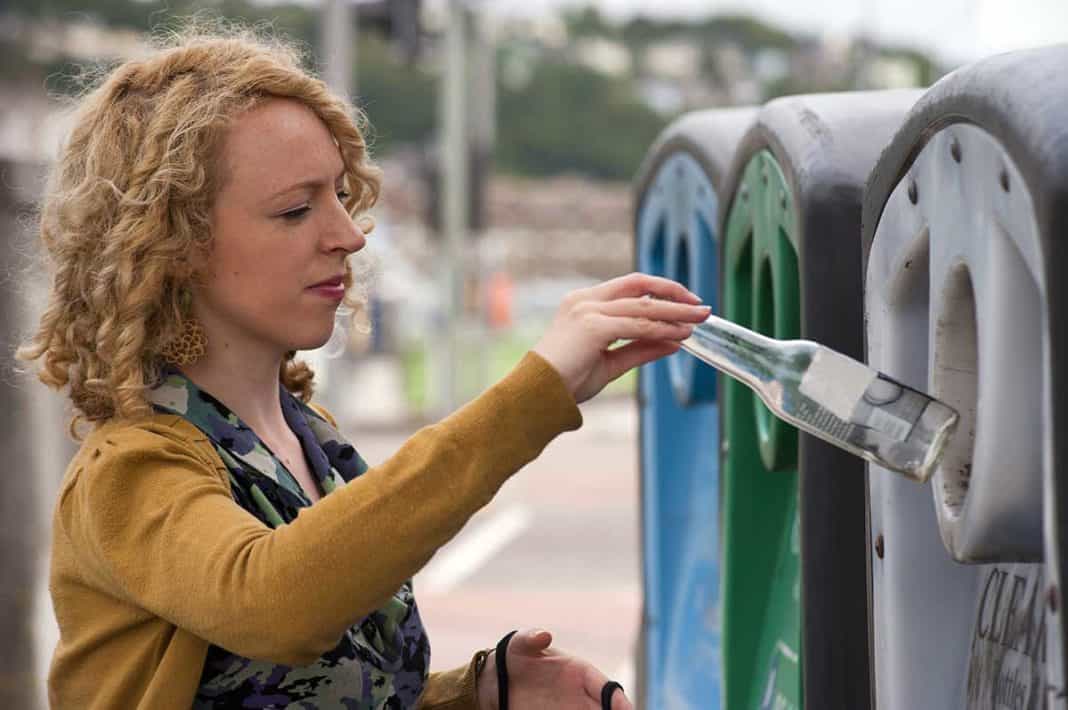KAGAWONG – Glass recycling has been a troubling issue for most Island municipalities since it was cancelled by third party contractor GFL. As part of Waste Reduction Week, Central Manitoulin and the Township of Billings co-hosted a panel discussion on glass recycling, resulting in an informative dialogue about the challenges around the material, the proposed blue box producer responsibility regulation and potential solutions for communities.
Guest presenter Peter Hargreave of Policy Integrity Inc. began with an overview of recycling in Ontario. Statistics Canada reports that Ontario generates approximately 12.7 million tonnes of waste annually, he said. Of this, the industrial-commercial-institutional (ICI) sector accounts for 60 percent with the remaining 40 percent coming from the residential materials which municipalities are required to manage. It’s a big undertaking for municipalities: Ontario municipalities spend around $1.2 billion overall to manage residential waste. This is escalating year over year as waste streams become more complex.
“When you look at waste, we are consuming more and more products and materials,” said Mr. Hargreave. This has a cascading impact that is environmental, economic and social. “People talk about greenhouse gas (GHG) emissions coming from the landfill but miss the larger aspect of resource and material extraction as well as the transportation and processing of those materials, all of which have a significant associated GHG impact. We need to avoid the generation of waste in the first place or allow resources to be reused,” he suggested. “There is a significant economic, environmental and social opportunity associated with that. That’s really what a number of people have been pushing for some time. We need to get ahead of this waste issue.”
The blue box curbside recycling program originated in Ontario in the 1980s around the same time that beverage manufacturers were moving away from refillable glass containers to single-use plastic bottles. “The soft drink industry saw the blue box program as a real opportunity to move away from refillable laws that were in place in the province,” he said. The industry suggested the blue box program would be money generating for municipalities and offered to voluntarily fund some of the curbside municipal programs if the province agreed to relax the refillable laws.
The money generation never happened. “Blue boxes continue to cost municipalities more and more over the years,” Mr. Hargreave said. “We saw that shift away from refillable bottles in the 1980s. In the 1990s the province started requiring municipalities or communities with a population over 5,000 to have curbside recycling programs in place. They required that glass, metal, plastic and fibre be included in those programs. Through the 1990s we saw a proliferation of new programs moving forward across the province.”
The government helped fund some initial costs but eventually the programs couldn’t make ends meet. In the early 2000s, Ontario legislated producers to pay 50 percent of the cost of the blue box program. “Right now we’re in this model where municipalities submit their costs and it’s roughly a 50-50 share between producers and municipalities,” he said. New legislation was introduced in 2016 to try to move to a full producer responsibility system. Over that time period we’ve seen a monumental shift in the types of materials we consume. There has been a wholesale change to plastic products and plastic packaging and a shift away from glass and metal. There are multi-material products and a continuous evolution of complex materials making the system untenable for municipalities to manage and requiring more and new optical sorters and sorting technologies by recyclers.
We are also dealing with weak end markets, he explained. For many materials, it’s cheaper to use virgin materials than it is to use recycled content and the markets have different quality demands. “For years we sent materials to countries like China and India but as their economies have developed they’ve begun to reject our waste.” Countries such as the Philippines have sent waste back to Canada. There are other emerging issues. Many companies are trying to improve their packaging and to be environmentally conscious but there are also companies that are branding their materials recyclable when nothing could be further from the truth. “The big pet peeve right now in the municipal world is compostable packaging,” he said. “It’s labeled as compostable but I’m not sure any facility in the province can actually properly process it. Municipalities are dealing with these issues on a constant basis but do not have resources or abilities to be able to influence what’s happening within the companies that are producing these products.”
In Ontario, capacity is an issue. “I think Manitoulin has some capacity available to the municipalities but certainly in lots of parts of Ontario there is this dwindling capacity and we do end up sending huge amounts of material into the United States,” said Mr. Hargreave. About a third of our disposal needs are satisfied by New York and Michigan, where we ship about four million tonnes of waste every year.
Municipalities really have little ability to influence the materials that are coming through the system on the product design side, he said, and they are generally unable to have an influence on what the end markets are asking for. “They’re stuck in this position of constantly trying to figure out what to do with these materials but they have little ability to influence that. They have the ability to communicate with residents very clearly but not the ability to influence both product design and end market for commodities.”
Ontario has a very strong glass deposit return system with the beer industry with some of the best collection and reuse rates in the world, but with the entry of more craft breweries there is once again a slow move away from the refillable side and at the same time there is also a move away from industry standard bottle.
However, he added, glass has many uses. New bottles can be made from those collected. Glass is often used for insulation, for aggregate replacement, building supplies and sandblasting materials. “The issue for recycling programs is these materials are generally collected in a comingled way so glass is mixed with other materials. There is upwards of 30 to 40 percent contamination within that glass.”
In the early days of the blue box program, glass was being separated at the truck and contamination wasn’t an issue but that collection structure was quite costly, he said, and there were also some issues with workers around source separating at curb. The move to comingling was when the contamination problems began.
Contamination is where caps and small pieces of plastic get mixed with the glass making it unacceptable for commodity markets. Another issue with glass, specifically for Northern or more remote communities, is distance to market. Glass is heavy; it’s expensive to transport and that’s a continual issue for the glass markets.
There have always been market disruptions, slowdowns and devaluing in recycling, said Jo-Anne St. Godard, executive director of the Recycling Council of Ontario. This is attributable to any kind of supply chain issue or production slowdown but if the economic reasons of why we want to collect glass are diminished it makes it very difficult to justify collecting it in blue boxes or any other collection system. That being said, the more clean and intact you can keep any recycled material, but particularly with glass, throughout the collection cycle the more valuable it is.
“Glass being what it is tends to break in the collection process, particularly when it’s mixed with other materials in a comingle situation and it’s being bounced around,” said Ms. St. Godard. “It makes it very, very difficult at that point then to collect it.”
Broken glass actually can become embedded in other materials and renders those materials less valuable or more difficult to recycle, she explained. “Sometimes it gets embedded in the fibre. Sometimes it gets into the nooks and crannies of the plastics container. Any time you have a mix of materials in the collection system you have to go through much more effort to separate it into their sources and to regain their value in the markets.”
This, in fact, was the case for LCBO containers transitioning out of the blue box program and into the deposit return in the Beer Store system. Glass and aluminum mix well because aluminim is unscathed by broken glass.
Ultimately, if there is a lower value on glass it’s likely that there is low demand and collection renders the material in a state that is more costly to try to reintegrate into production through the recycling system, she said.
Central Manitoulin Councillor Al Tribinevicius knows glass. He was an immigrant growing up in Hamilton after World War II. He spent one summer as a replacement worker at Dominion Glass, where he worked on the hot mould line, with hot amber “stubbies” (short beer bottles) coming out of the moulds in rapid succession. Deformities and breakage were common. The broken glass was put into large steel bins and sent back into the furnace for remoulding, he explained. This material was called “cullet”; there was “internal cullet” and “external cullet.”
“External cullet is our main problem,” he said. “The waste trucking outfit from Blind River will no longer pick up glass waste in separate blue boxes for this reason. Some bottles sold locally have metal screw caps with plastic liners. These caps will leave a metal collar on the bottle after the cap is removed.” The remaining ring should be removed but this is difficult without tools such as wire cutters, Mr. Tribinevicius said, and the process often leaves him with nicks or cuts on his hands.
“Heat-resistant glass, such as Pyrex or borosilicate glass, must not be part of the mix because even a small piece of such material will alter the viscosity of the fluid in the remelt furnace. Paper labels on glass and the glues used to keep them attached do not appear to cause a problem in the recycling stream,” he continued.
“Then there’s window glass, which has a different chemical composition as does mirror glass, car windshield glass and glass used in LED lighting, fluorescent tubes and leaded crystal glass for wine or highballs. These must be kept separate at the landfill site,” he said.
Waste fluorescent tubes and LED lights are collected at Central Manitoulin’s municipal garage during the annual hazardous waste day in July.
“Our municipality is considering drop off points to collect all glass food containers (jars and bottles) and put them through a gasoline or diesel engine powered crusher or hammer mill that will produce a sand-like material to be used as landfill cover at the Providence Bay landfill site,” said Mr. Tribinevicius. “We don’t own a truck which has large forks to lift and tip collection bins.”
He looked at Tehkummah’s truck and found it was a simple compactor of garbage, which he explained as “a glass crushing machine that sits on a plywood base which could be put atop a 45-gallon drum. The crusher had a 5 hp gasoline engine, crushing chamber and an inlet chute. It was fed by hand.”
Mr. Tribinevicius spoke to Dale McCauley, who works at the Big Lake dump and had used the machine when he worked at Tehkummah. Mr. McCauley said the machine worked well except for a certain bottle type which was thrown out the inlet chute. “My thought had been to ask a local welder to construct a similar machine and set it up at the Providence Bay landfill site, until I heard this story,” Mr. Tribinevicius said. “We do not want our workers with injuries caused by flying glass. Unacceptable, period.”
Under the proposed blue box regulation, glass is a material that would fall under producer responsibility. Kim Neale, climate change co-ordinator for Central Manitoulin and Billings, asked about the harmonization of current services as covered by the proposed regulation. “Right now we can’t get our tenders to include glass recycling,” she said. “It wasn’t feasible for them. If we don’t have it now but glass has to be included in the future, are we potentially in a position where they might say to us, ‘we’re not going to pick up your glass because we’re not doing it right now?’”
Mr. Hargreave replied that the regulation as proposed will require a standardized level of service across the province.
Companies would likely come together in some form of collective and work together to determine how to achieve targets, he said. It makes sense for them to continue to work with municipalities. The producers would develop a reverse supply chain for packaging materials while municipalities would continue to collect recyclable materials. Producers might not choose to support a curbside recycling program and instead look at a deposit return system, he said. “There are different ways that companies can approach this but I would expect that a lot of them would group together and work with municipalities so residents won’t really see much difference. The difference is what is happening is happening more behind the scenes; the relationships that are happening to process these materials to ensure that recycling infrastructure isn’t getting figured out through municipal budgets. It’s getting figured out because producers have targets to meet and they’ll want to ensure they have a system that meets them that is efficient. They will have much closer ties to the end markets so they can actually drive what gets to the end markets and who gets this material. Instead of the piecemeal system we have now, if the collected materials are all the same we can start to look at standardized management of waste.”
In a post-discussion follow up, Ms. Neale stated, “We continue to seek funding opportunities to address this waste issue. Several solutions could be available for us including the potential for a public-private partnership to purchase and operate a shared glass pulveriser that would recycle glass into sand that could be used for road construction and landfill cover; the potential for a glass refill business on the Island; and the potential for an Island-wide co-ordinated procurement process for glass recycling.” (Blue box regulations will be phased in through 2025.)
Last week Ms. Neale made a presentation at the Manitoulin Municipal Association meeting, suggesting the resurrection of an Island-wide waste management group in order to problem solve together. She also suggested the creation of a new collaborative climate change action group with representation from each Island community. “I would envision that this group could work to build project specific partnerships to address some of these shared climate change and waste management issues,” she said, adding “I think the presentation was well received and I look forward to following up with each stakeholder to gauge support for this collaborative planning approach that fits into our existing governance structures.”





